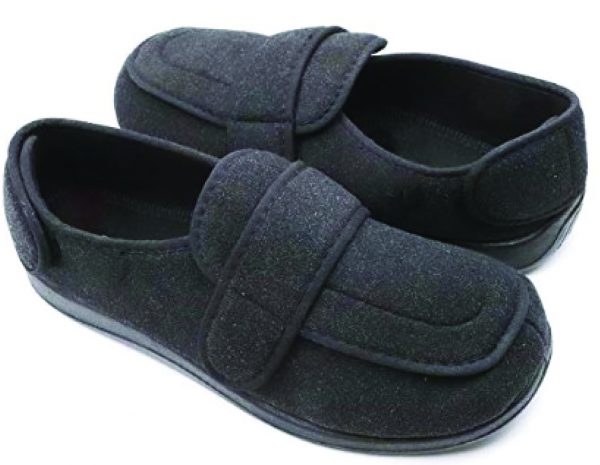
Table of Contents
Living with diabetes requires meticulous attention to various aspects of health, and foot care is no exception. One of the most critical components in diabetic foot care is wearing the right footwear. This article will explore the top features and benefits of diabetic shoes, designed specifically to protect and enhance the health of diabetic feet.
Understanding Diabetic Shoes
Definition and Purpose
Diabetic shoes, also known as therapeutic shoes, are specially designed footwear to reduce the risk of skin breakdown and other foot complications in people with diabetes. They offer superior support, cushioning and protection compared to regular shoes.
Difference Between Regular and Diabetic Shoes
While regular shoes focus on style and general comfort, diabetic shoes prioritize foot health. They provide additional depth, cushioning and support to accommodate foot deformities, swelling and orthotic devices, reducing the risk of injuries and enhancing overall foot health.
Key Features of Diabetic Shoes
Extra Depth and Width
Diabetic shoes have extra depth and width to accommodate swollen feet, bunions and hammertoes, providing a comfortable fit without pressure points.
Seamless Interior
The interior of diabetic shoes is designed to be seamless, preventing irritation, blisters and ulcers, which are common in diabetics with sensitive skin.
Protective Insoles
These shoes come with customizable and cushioned insoles that provide additional support and distribute pressure evenly, reducing the risk of foot injuries.
Adjustable Closures
Velcro straps or laces allow for easy adjustments to accommodate foot size changes throughout the day, ensuring a snug and comfortable fit.
Breathable Materials
Made from breathable materials, diabetic shoes help keep feet dry, reducing the risk of fungal infections and promoting overall foot health.
Firm Heel Counters
Firm heel counters provide added stability and support, essential for maintaining balance and reducing the risk of falls.
Benefits of Diabetic Shoes

Prevention of Foot Injuries
By reducing friction and pressure points, diabetic shoes prevent cuts, blisters and pressure ulcers, common issues for diabetic patients.
Improved Circulation
Enhanced circulation is vital for diabetics, and these shoes are designed to promote better blood flow, crucial for foot health.
Pain Reduction
Diabetic shoes alleviate foot pain associated with diabetes-related conditions by providing the necessary support and cushioning.
Enhanced Healing
By offering a better environment for foot wounds to heal, these shoes play a significant role in managing and preventing complications.
Increased Mobility
Comfort and stability are paramount in diabetic shoes, improving mobility and making it easier for individuals to stay active.
How to Choose the Right Diabetic Shoes
Professional Fitting
Having your feet measured by a professional ensures a perfect fit, crucial for avoiding complications.
Quality Materials
Go for shoes made from high-quality, breathable materials that enhance comfort and durability.
Consulting a Specialist
Consulting with a podiatrist or healthcare provider can provide recommendations tailored to your specific needs.
Considering Lifestyle Needs
Choose shoes that match your activity level and style preferences, ensuring you wear them consistently.
Regular Foot Inspections
Regularly check your feet for signs of pressure, redness or blisters to ensure your shoes are working effectively.
Types of Diabetic Shoes
Custom-Made Shoes
Custom-made shoes are tailored to fit the unique shape of your feet, providing maximum comfort and protection.
Off-the-Shelf Shoes
Off-the-shelf options are readily available and come in various styles, offering convenience and affordability.
Orthotic Inserts
Orthotic inserts can be added to regular shoes to provide additional support and cushioning, tailored to your specific needs.
Sandals and Slippers
Specialized diabetic sandals and slippers offer comfort and protection, even for indoor use.
Top Brands and Recommendations
Leading Brands
Explore leading brands known for their quality diabetic shoes, such as Dr. Comfort, New Balance and Orthofeet.
Recommended Models
Look for models highly recommended by podiatrists and diabetic specialists for their effectiveness and comfort.
Maintaining Your Diabetic Shoes
Cleaning Tips
Keep your shoes clean by regularly wiping them down and allowing them to air dry, preventing odors and infections.
When to Replace
Replace your diabetic shoes every 6-12 months or as recommended by your healthcare provider to ensure they remain effective.
Storing Properly
Store your shoes in a cool, dry place to maintain their shape and longevity.
Common Myths About Diabetic Shoes
Myth vs. Reality
Debunk common myths about diabetic shoes, such as they are unattractive or unnecessary and highlight their crucial role in foot health.
Success Stories and Testimonials
Real-Life Experiences
Share success stories and testimonials from individuals who have experienced significant benefits from wearing diabetic shoes.
Conclusion
Diabetic shoes are more than just footwear; they are a vital component of diabetes management, providing essential support, protection and comfort. Investing in a good pair of diabetic shoes can prevent complications, enhance your quality of life, and keep you on your feet.
FAQs
How often should I replace my diabetic shoes?
It is recommended to replace your diabetic shoes every 6-12 months or as advised by your healthcare provider.
Can I wear regular shoes with orthotic inserts instead of diabetic shoes?
While orthotic inserts can provide additional support, diabetic shoes are specifically designed to offer the best protection and comfort for diabetic feet.
Are diabetic shoes covered by insurance?
Many insurance plans, including Medicare, cover diabetic shoes. Check with your provider for specific coverage details.
Do I need a prescription for diabetic shoes?
Yes, a prescription from a healthcare provider is often required to get diabetic shoes,
especially for insurance coverage purposes.
Can diabetic shoes help with other foot conditions?
Yes, diabetic shoes can benefit individuals with other foot conditions like arthritis, bunions and plantar fasciitis due to their supportive and cushioned design.




One thought on “Diabetic Shoes: Discover Top Features and Benefits for Optimal Foot Health”